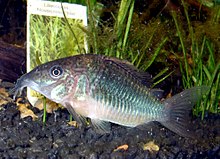Corydoras splendens
| Emerald catfish | |
|---|---|
 |
|
|
Not evaluated (IUCN 3.1)
|
|
| Scientific classification | |
| Kingdom: | Animalia |
| Phylum: | Chordata |
| Class: | Actinopterygii |
| Order: | Siluriformes |
| Family: | Callichthyidae |
| Genus: | Corydoras |
| Species: | C. splendens |
| Binomial name | |
|
Corydoras splendens (Castelnau, 1855) |
|
| Synonyms | |
|
|
The emerald catfish (Corydoras splendens) is a tropical freshwater fish belonging to the Corydoradinae sub-family of the Callichthyidae family native to the Amazon Basin in South America. It has traditionally been known as Brochis splendens. The fish has appeared on a stamp in Brazil.
It was originally described as Callichthys splendens by François Louis de la Porte, comte de Castelnau in 1855. This species was once also commonly called Brochis coeruleus. W. A. Gosline was the first to suspect that the two species were the same in 1940, but it was actually Njiseen & Isbrücker in 1970 who combined the two, giving sufficient reasons for doing so. The species would be described as Brochis splendens, until most of the catfish formerly classified as Brochis were re-classified into Corydoras. The current recognized classification is thus Corydoras splendens.
It is native to the upper reaches Amazon Basin. This includes Ucayali River to Pucallpa, Ambiyacu River, and the area around Iquitos in western Brazil, southeastern Colombia, eastern Ecuador and eastern Peru.
Depending upon the angle of lighting, the fish's body reflects a metallic green, blue-green, or even a bluish color. The ventral area is yellowish with the pectoral, ventral, and anal fins yellowish and the dorsal, caudal, and adipose fins a translucent brownish. The females are larger and more robust than the males, and have a more pinkish belly as opposed to the more yellowish one for the males. This fish can be distinguished from the green/bronze corydoras catfish by its usually larger size, stouter body, and more pointed snout.
...
Wikipedia
